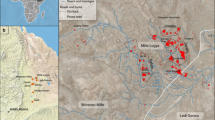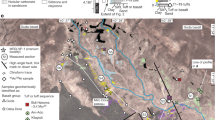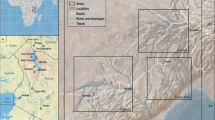Abstract
All six known specimens of the early hominid Sahelanthropus tchadensis come from Toros-Menalla site 266 (TM 266), a single locality in the Djurab Desert, northern Chad, central Africa. Here we present a preliminary analysis of the palaeontological and palaeoecological context of these finds. The rich fauna from TM 266 includes a significant aquatic component such as fish, crocodiles and amphibious mammals, alongside animals associated with gallery forest and savannah, such as primates, rodents, elephants, equids and bovids. The fauna suggests a biochronological age between 6 and 7 million years. Taken together with the sedimentological evidence, the fauna suggests that S. tchadensis lived close to a lake, but not far from a sandy desert, perhaps the oldest record of desert conditions in the Neogene of northern central Africa.
This is a preview of subscription content, access via your institution
Access options
Subscribe to this journal
Receive 51 print issues and online access
$199.00 per year
only $3.90 per issue
Buy this article
- Purchase on Springer Link
- Instant access to full article PDF
Prices may be subject to local taxes which are calculated during checkout


Similar content being viewed by others
References
Brunet, M. et al. The first australopithecine 2,500 kilometres west of the Rift Valley (Chad). Nature 378, 273–275 (1995)
Brunet, M. et al. Australopithecus bahrelghazali, une nouvelle espèce d'Hominidé ancien de la région de Koro Toro (Tchad). C.R. Acad. Sci. Paris 322, 907–913 (1996)
Brunet, M. et al. Tchad: découverte d'une faune de mammifères du Pliocène inférieur. C.R. Acad. Sci. Paris 326, 153–158 (1998)
Brunet, M. & MPFT Chad: Discovery of a vertebrate fauna close to the Mio-Pliocene boundary. J. Vert. Paleontol. 20, 205–209 (2000)
Brunet, M. et al. A new hominid from the Upper Miocene of Chad, Central Africa. Nature 418, 145–151 (2002)
Ghienne, J. F., Schuster, M., Bernard, A., Duringer, P. & Brunet, M. The Holocene giant Lake Chad revealed by Digital Elevation Models. Quat. Int. 87, 81–85 (2002)
Hunter, R. E. Basic types of stratification in small eolian dunes. Sedimentology 24, 361–387 (1977)
Hunter, R. E. & Kocurek, G. An experimental study of subaqueous slipface deposition. J. Sediment. Petrol. 56, 387–394 (1986)
Duringer, P. et al. First discovery of fossil dung beetle brood balls and nests in the Chadian Pliocene australopithecine levels. Lethaia 33, 277–284 (2000)
Schuster, M. et al. Découverte de termitières fossiles dans les sites à vertébrés du Pliocène tchadien: description, identification et implications paléoécologiques. C.R. Acad. Sci. Paris 331, 15–20 (2000)
Seignobos, C. in Datation et Chronologie dans le Bassin du lac Tchad Série Colloques & Séminaires ORSTOM (eds Barreteau, D. & Von Graffenried, C.) 165–182 (ORSTOM, Paris, 1993)
Stewart, K. M. in Neogene Paleontology of the Manonga Valley, Tanzania Topics in Geobiology Vol. 14 (ed. Harrison, T.) 333–349 (Plenum, New York, 1997)
Bonis, de L., Bouvrain, G., Geraads, D., Koufos, G. D. & Sen, S. The first aardvarks (Mammalia) from the late Miocene of Macedonia, Greece. Neues Jahrbuch Geol. Paläont. Abhandlungen 194, 343–360 (1994)
Eisenmann, V. & Whybrow, P. J. in Fossil Vertebrates of Arabia (eds Whybrow, P. J. & Hill, A.) 234–253 (Yale Univ. Press, New Haven, 1999)
Tassy, P. in Geology of the Albertine Rift Valley, Uganda–Zaire Vol. II (eds Senut, B. & Pickford, M.) 217–257 (CIFEG Occas. Publ., Orléans, 1994)
Harris, J. M. & White, T. D. Evolution of the Plio-Pleistocene African Suidae. Trans. Am. Phil. Soc. 69(2), 1–128 (1979)
Coryndon, S. C. The taxonomy and nomenclature of the Hippopotamidae (Mammalia, Artiodactyla) and a description of two new fossil species. Proc. Koninklijke Neder. Akad. Wetenschappen B 80, 61–88 (1977)
Gentry, A. W. Fossil Bovidae (Mammalia) from Langebaanweg, South Africa. Ann. S. Afr. Mus. 79(8), 213–337 (1980)
Lehmann, U. & Thomas, H. in Neogene Paleontology and Geology of Sahabi (eds Boaz, N. T., El-Arnauti, A., Gaziry, A. W., de Heinzelin, J. & Boaz, D. D.) 323–335 (Liss, New York, 1987)
Gentry, A. W. in Neogene Paleontology of the Manonga Valley, Tanzania Topics in Geobiology Vol. 14 (ed. Harrison, T.) 107–135 (Plenum, New York, 1997)
Thomas, H. in Proc. 8th Panafrican Congress of Prehistory (eds Leakey, L. E. F. & Ogot, B. A.) 82–91 (Nairobi, 1977)
Leakey, G. M. et al. Lothagam: a record of faunal change in the Late Miocene of East Africa. J. Vert. Paleontol. 16, 556–570 (1996)
McDougall, I. & Feibel, C. S. Numerical age control for the Miocene–Pliocene succession at Lothagam, a hominoid-bearing sequence in the northern Kenya Rift. J. Geol. Soc. Lond. 156, 731–745 (1999)
Gaziry, A. W. in Neogene Paleontology and Geology of Sahabi (eds Boaz, N. T., El-Arnauti, A., Gaziry, A. W., de Heinzelin, J. & Boaz, D. D.) 287–302 (Liss, New York, 1987)
Geraads, D. Vertébrés fossiles du Miocène supérieur du Djebel Krechem el Artsouma (Tunisie centrale). Comparaisons biostratigraphiques. Géobios (Lyon) 22, 777–901 (1989)
Pickford, M. & Senut, B. The geological and faunal context of Late Miocene hominid remains from Lukeino, Kenya. C.R. Acad. Sci. Paris 332, 145–152 (2001)
Deino, A. L., Tauxe, L., Monaghan, M. & Hill, A. 40Ar/39Ar geochronology and paleomagnetic stratigraphy of the Lukeino and lower Chemeron Formations at Tabarin and Kapcheberek, Tugen Hills, Kenya. J. Hum. Evol. 42, 117–140 (2002)
Tassy, P. Nouveaux Elephantoidea (Mammalia) dans le Miocène du Kenya Cahiers de Paléontologie, Travaux Paléontologie Est-africaine (CNRS, Paris, 1986)
WoldeGabriel, G. et al. Ecological and temporal placement of early Pliocene hominids at Aramis, Ethiopia. Nature 371, 330–333 (1994)
WoldeGabriel, G. et al. Geology and palaeontology of the Late Miocene Middle Awash valley, Afar rift, Ethiopia. Nature 412, 175–178 (2001)
Leakey, M. D. & Harris, J. M. (eds) Laetoli: A Pliocene Site in Northern Tanzania 524–531 (Clarendon, Oxford, 1987)
Acknowledgements
We thank the Chadian authorities (Ministère de l'Education Nationale de l'Enseignement Supérieur et de la Recherche, the Université de N'djamena, and CNAR). We extend gratitude for their support to the French Ministries, Ministère de l'Education Nationale (Faculté des Sciences, Université de Poitiers), Ministère de la Recherche (CNRS) and Ministère des Affaires Etrangères (Direction de la Coopération Scientifique, Universitaire et de Recherche, Paris, and SCAC Ambassade de France à N'djamena), to the Région Poitou-Charentes, the Département de la Vienne, the Association pour le Prix scientifique Philip Morris, and also to the Armée Française (MAM and Epervier) for logistic support. Many thanks to the National Museum of Kenya, National Museum of Ethiopia and University of California, who allowed us access to their collections. We especially thank A. Djimdoumalbaye, A. Beauvilain, J.-C. Bertrand, F. Gongdibé, M. Adoum and X. Valentin for field and technical work and all the other MPFT participants to our field missions. We thank F. Clark Howell, Y. Haile-Selassie, M. G. Leakey, D. Lieberman, M. Muungu, D. Pilbeam and T. White for insights and comments. We are most grateful to G. Florent for administrative guidance of the MPFT.
Author information
Authors and Affiliations
Corresponding author
Ethics declarations
Competing interests
The authors declare that they have no competing financial interests.
Rights and permissions
About this article
Cite this article
Vignaud, P., Duringer, P., Mackaye, H. et al. Geology and palaeontology of the Upper Miocene Toros-Menalla hominid locality, Chad. Nature 418, 152–155 (2002). https://doi.org/10.1038/nature00880
Received:
Accepted:
Issue Date:
DOI: https://doi.org/10.1038/nature00880
This article is cited by
-
Postcranial evidence of late Miocene hominin bipedalism in Chad
Nature (2022)
-
The Thorny Issue of African Porcupines: a New Mandible of Hystrix makapanensis from Olduvai Gorge (Tanzania) and Rediagnosis of the Species
Journal of Mammalian Evolution (2022)
-
Paleoecological Inferences from Long Bone Microanatomical Specializations in Hippopotamoidea (Mammalia, Artiodactyla)
Journal of Mammalian Evolution (2021)
-
Acquisition of terrestrial life by human ancestors influenced by forest microclimate
Scientific Reports (2017)
Comments
By submitting a comment you agree to abide by our Terms and Community Guidelines. If you find something abusive or that does not comply with our terms or guidelines please flag it as inappropriate.



